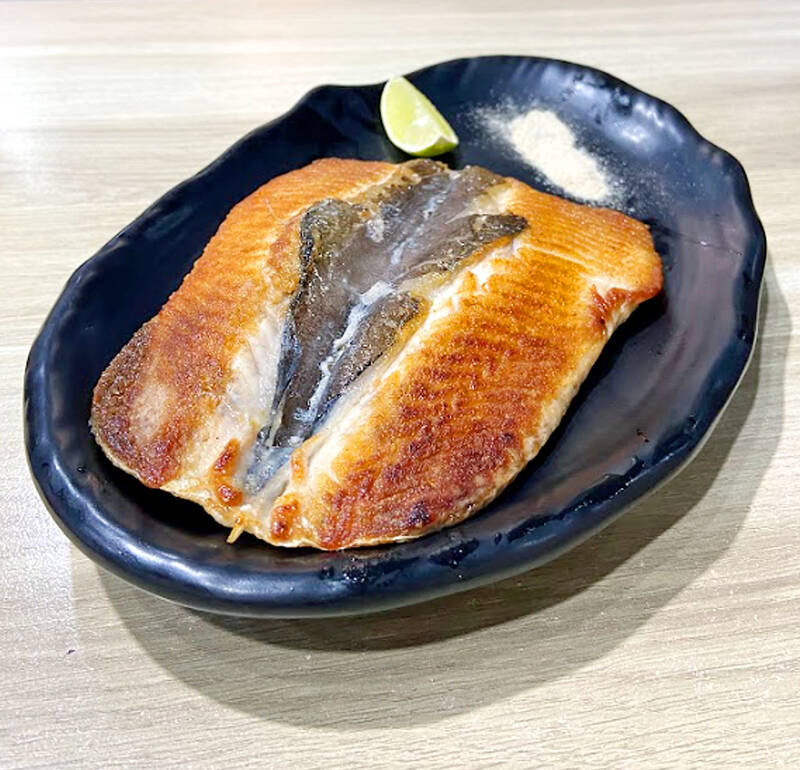According to legends, Cheng Cheng-kung (also known as Koxinga) is said to be associated with another Taiwanese food — milkfish. When Cheng was fighting the Dutch who were stationed at their fort named Fort Zeelandia, they lacked supplies and food, and couldn’t catch any fish to eat. As he worried about running out of food, one night, the sea goddess Matsu appeared in his dream and said, “Don’t say no fish. (Mo-shuo-mo-yu) There are fish in the sea near where your navy is at anchor.”
據說鄭成功還與另一道台灣美食有關—虱目魚。當鄭成功與堅守在熱蘭遮堡的荷蘭人交戰時,軍隊缺乏補給,無糧可食,也捕不到魚可吃。正當為食物發愁時,一天夜裡媽祖在他夢中指點:「莫說無魚。你的水師駐紮的海邊就有魚。」
station (v.) 駐紮

Photo: Bookman l 圖片:書林
Fort Zeelandia (n.) 熱蘭遮堡,遺址位於現今的安平古堡內。
goddess (n.) 女神
The next day, Cheng sent his soldiers to fish at the location indicated by Matsu, and as predicted, they caught a lot of fish. Not knowing the name of the fish, he called them shuo-mo-yu (which means “say no fish”), just as Matsu had instructed him in his dream. Another version of the story suggests that, when Cheng landed in Taiwan, nearby fishermen offered some fish to him. When Cheng asked, “Shi-me-yu?” (meaning “What fish?”), the fishermen mistakenly understood what he said to be the name of the fish.
隔天鄭成功派兵去媽祖指點的地方捕魚,果真如祂所說捕到很多魚,但是因為不知道怎麼稱呼,於是以媽祖夢中所說的「說無魚」命名為「虱目魚」。另有一說是鄭成功登陸時,附近的漁民獻魚,他問是「什麼魚」,漁民誤以為鄭成功稱此魚為「虱目魚」,因而得名。
indicate (v.) 指示;暗示
mistakenly (adv.) 錯誤地
The appearance of the goddess in the dream adds a touch of mystery, making the story a legend. Whether you believe the story or not, one certain thing is that Cheng successfully expelled the Dutch, ending the Dutch company’s colonial rule in Taiwan. To support the anti-Qing military movement to restore the Ming, Cheng actively farmed the land and developed Taiwan. In appreciation of his contribution to Taiwan, many temples have been built to honor Cheng, and he was deified the title Kaitai Shengwang (meaning “The Divine Who Developed Taiwan”). The Koxinga Museum in Tainan is also named after him and houses collections from the Ming and Qing dynasties.
神明託夢讓虱目魚的故事增添傳奇色彩。無論你是否相信,可以確定的是鄭成功戰勝荷蘭人,結束荷蘭東印度公司在台灣的殖民統治。鄭成功積極開墾台灣,作為日後反清復明的基地,為感念鄭成功的貢獻,各地有供奉鄭成功的廟宇,尊稱開台聖王。台南市鄭成功文物館便是以他命名,典藏許多明清時期的文物。
expel (v.) 強迫(某人)離開;驅逐
restore (v.) 恢復
deify (v.) 把...當作神;神化
Milkfish is one of the most popular and affordable fish frequently appearing on Taiwanese households’ dining tables. This versatile fish has a tender yet firm texture, and can be prepared in several ways, from frying to making congee. With the many advantages that milkfish offers, people don’t mind the minor inconvenience of pulling out the tiny fish bones before eating it. In Tainan, milkfish is even used to make fishballs that have a bouncy, chewy texture. This specialty has become very popular and now it is common to find these fishballs in supermarkets all over Taiwan.
虱目魚是台灣人頗愛的魚類,價格實惠,肉質軟而紮實,時常出現在台灣家庭餐桌上,其料理方式多元,可用來煎魚或是煮粥。這麼多優點,在吃之前要挑魚刺的不便,也就無傷大雅了。在台南還將虱目魚做成魚丸,口感彈牙,廣受大眾喜愛,因而在各大超市都買的到。
affordable (adj.) 價格實惠的,擔得起的
versatile (adj.) 用途廣泛的,多功能的
tender (adj.) (食物)細嫩的,軟的
congee (n.) 粥
fishball (n.phr.) 魚丸
文章由書林出版公司提供:
www.bookman.com.tw

A: When is the Lantern Festival? B: The festival is celebrated on the 15th day of the first month of the lunar calendar, which fell on Feb. 12 this year. A: Oh no! Did I miss the 2025 Taipei Lantern Festival? B: Yes, you did. But you can still go to the 2025 Taiwan Lantern Festival in Taoyuan, which will run until this Sunday. A: Let’s go admire the exuberant lanterns. A: 元宵節到底是哪一天? B: 就是農曆1月15日啊,今年則落在國曆2月12日。 A: 喔不,我是不是錯過了2025台北燈節? B: 是的,但你還可以去桃園的2025台灣燈會,活動將持續至週日。 A: 那我們去欣賞豐富的花燈秀吧! (By Eddy Chang, Taipei Times/台北時報張聖恩)

A: What’s the theme of the 2025 Taiwan Lantern Festival’s main lantern? B: The theme is “Paradise,” and the main lantern is a snake-shaped “infinity” symbol that features a lighting show every half an hour. A: Cool, I heard that there are over 300 lanterns. B: There are even giant lanterns in the shape of Pikachu and some other popular Pokemon characters. A: Let’s go now. A: 2025台灣燈會主燈的主題是什麼? B: 主題是「無限樂園」!主燈的造型則是蛇形的數學「無限號」,主燈每半小時還有一次燈光秀。 A: 酷喔,聽說總共有300多件花燈作品。 B: 甚至還有皮卡丘和其他熱門寶可夢角色的巨型花燈呢。 A: 哇我們現在就出發吧! (By Eddy Chang, Taipei Times/台北時報張聖恩)

本文由生成式AI協作,本刊編輯編修。 Tucked away in southwestern Taiwan, Yunlin County is a treasure trove of cultural heritage, rich history, and natural beauty. From its stunning temples and glove puppetry to historical architecture and picturesque landscapes, Yunlin rewards those who venture off the beaten path. Yunlin is renowned for its flourishing temple culture. Temples in this region are not merely places of worship but also communal centers where people gather for festivals, rituals, and social functions. One of the most notable temples here is the Beigang Chaotian Temple, which was built more than 300 years ago and is dedicated to Matsu, the sea

Nestled within the heart of Taipei, National Taiwan University (NTU) contains a grand and spacious sanctuary where nature and academia come together in perfect accord. Across its expansive 111-hectare campus, NTU reveals a landscape rich with history, lush greenery, and a thoughtfully preserved ecosystem. This tranquil haven invites visitors to take their time wandering among the elegant buildings, to admire the rare plants, and to experience a space that exudes quiet inspiration. Zhoushan Road: A Gentle Prelude to NTU’s Tranquility Beginning at Gongguan MRT Station, the enchanting avenue Zhoushan Road leads visitors into NTU shaded by golden rain trees, cottonwoods, and Javanese